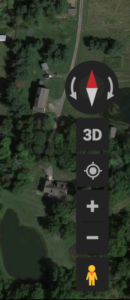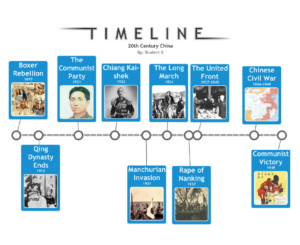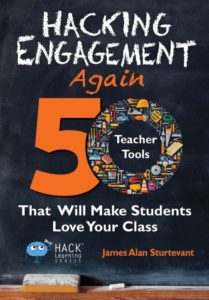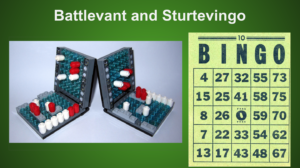
A great way to engage students is to just have some fun with content. Accomplish this by mimicking two iconic American board games…Battleship and Bingo. Certainly, most of your kids have played, or at least are familiar with both. I reworked both games for my classroom. Of course, I renamed them Battlevant and Sturtevingo. I encourage you to create your own labels for your versions of these activities.
Any time there’s material you’d like to review, Sturtevingo and Battlevant are wonderful engaging options that can be employed frequently. Battlevant is a team game. I’ll demonstrate it as a two team contest, but it could be used with multiple teams. In Sturtevingo, every man and woman is on their own.
Two team Battlevant is played in the following way:
- Divide the class into 2 teams
- Secretly assign students in Team 1 a number from 1-20. Select 5 numbers as misses and assign the other 15 numbers. If there are less than 15 students in Team 1, you can award extra numbers to various kids. Repeat the same process for Team 2 with numbers 21-40.
- Prior to the contest, project the game board.
Battlevant Game Board
| Team 1 |
Team 2 |
| 1 2 3 4 5
6 7 8 9 10
11 12 13 14 15
16 17 18 19 20 |
21 22 23 24 25
26 27 28 29 30
31 32 33 34 35
36 37 38 39 40 |
- Ask individual students questions about the material. If they get it right, they can select a number from the other team’s range of numbers. (Team 1 kids will select numbers from 21 to 40)
- If they successfully uncover a student’s number, you cheerfully announce that Johnny or Janey has been sunk and put an X through their number. If a student guesses a number that is a miss, circle that number.
- Johnny or Janey, if sunk, must then slightly turn their desks to demonstrate their damaged status. They may not answer general questions, but I like to issue “Back from the Dead” questions periodically to keep the sunk students engaged.
- The contest ends when the questions are exhausted, or all the kids on one side are sunk.
Sturtevingo is a game that takes a bit more prep, but is easy to execute. Create at least 25 matching questions. I like to create 30 because it makes obtaining Sturtevingos even more challenging. The first portion of the period, students are working individually, or in small groups, matching concepts with descriptions like below:
- ______ Karma
- ______ Dharma
- ______ Khyber Pass
- ______ Aryans
- ______ Bhagavad Gita
a. Northwestern passageway for invasion and migration
b. The Hindu concept of duty
c. The law of action and reaction
d. The Hindu scripture that describes and promotes Dharma and Karma
e. Invaders, or migrants, from the west that transformed the culture of the Subcontinent
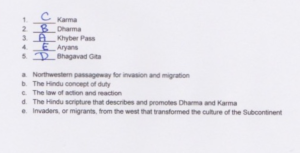
After kids have answered as many as they can, or the allotted time has expired, handout a blank Sturtevingo board:
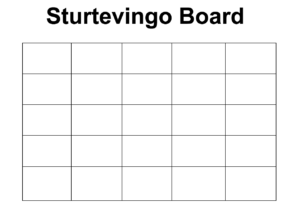
Students will then populate the board with number letter matches. Encourage students to place the matches in a random fashion. That way, each student’s Sturtevingo board will be unique. The matches must be accurate to count. If a student put the letter A with number 1 when the answer should be C, they cannot be awarded the square if “1C” is called. Once kids have their game boards arranged, play commences in the following fashion:
- The teacher asks a question from the list. If a student guesses correctly, “I think letter C goes with question 1” all the students that have the 1C match on their board can place an X on that square. You write 1C on the board.
- The student that answered correctly then walks up to the teacher and subtly points to the next question they want asked. I frequently limit the number of times any student can answer to share the wealth.
- Play continues till a student get 5 Xs in a row.
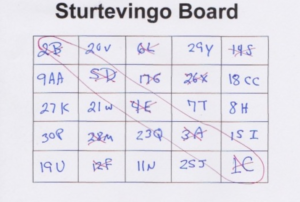
- Unlike regular bingo however, don’t instruct kids to clear the board after the first Sturtevingo. Just keep asking questions and announcing number letter matches. It’s even okay if some kids get 2 Sturtevingos.
- I like to up the intensity by rewarding Sturtevingo winners. It could be classroom privileges, a free homework coupon, or any coveted reward you can think of.
Template
The Problem:
Teachers struggle making dull content engaging.
The Solution:
Play Battlevant, or Sturtevingo.
What you can do Tomorrow:
- Create a number of questions based on the content. If you’re going to play Sturtevingo, make the questions matching.
- Decide if you want teams…Battlevant, or every man and woman for themselves…Sturtevingo.
- Craft some additional questions (trivial and or interesting) that can be thrown out to supplement the material. These could be used to engage students sunk in Battlevant, or could spice up the competition of either game.
These games are a way to take dull content and make it fun and engaging.
Listen to “68-BattleVant and SturteVingo…Two Zero Tech Ways to Engage Kids” on Spreaker.

